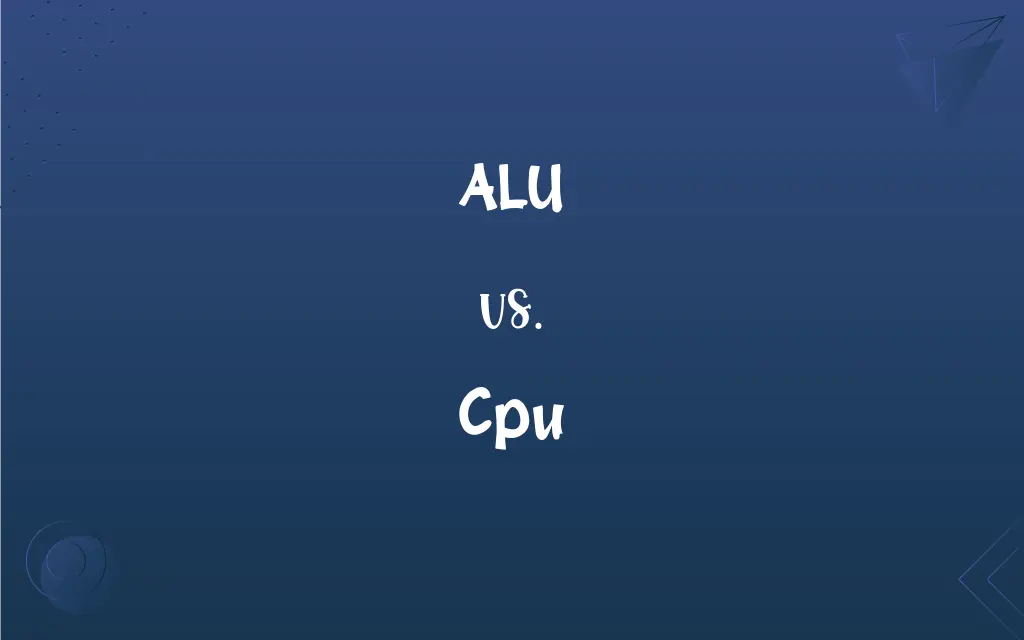ALU vs. CPU: What's the Difference?
Copy edited by Janet White || By Harlon Moss || Updated on October 4, 2023
ALU performs arithmetic and logical operations; CPU is the central processing unit coordinating overall computer operations.

Key Differences
The ALU, or Arithmetic Logic Unit, is a critical component within the CPU. While the ALU specifically deals with arithmetic and logical operations, the CPU, or Central Processing Unit, serves as the computer's brain, orchestrating tasks across various components.
ALU's main job is to undertake mathematical operations like addition and subtraction, as well as logical operations like comparing numbers. The CPU, on the other hand, interprets and executes instructions from the computer's memory.
Within the architecture of the CPU, the ALU is just one part. The CPU has other units such as the control unit and memory cache. Thus, while the ALU focuses solely on arithmetic and logic, the CPU ensures the smooth running of the entire computer system.
A computer can't function without a CPU because it manages every process and task. Within this essential CPU, the ALU ensures that mathematical and logical computations occur efficiently.
Think of the ALU as a specialist within a team, dedicated to specific tasks. In contrast, the CPU is the team leader, ensuring every member and process works in harmony.
ADVERTISEMENT
Comparison Chart
Function
Performs arithmetic and logical operations
Coordinates and executes system tasks
Position
Component within the CPU
Primary processing unit of a computer
Operations
Addition, subtraction, comparisons, etc.
Fetch, decode, execute instructions
Independence
Can't operate independently
Can function with its components
Complexity
Less complex in design
More intricate with multiple components
ADVERTISEMENT
ALU and CPU Definitions
ALU
ALU performs both arithmetic and logical operations.
In the CPU, the ALU efficiently calculates numbers and comparisons.
Cpu
CPU stands for Central Processing Unit.
The CPU is the heart of any computing device.
ALU
ALU can handle tasks like addition, subtraction, and comparisons.
The ALU's ability to quickly process arithmetic helps in software calculations.
Cpu
CPU is the primary decision-maker in a computer system.
A faster CPU results in smoother multitasking and software operations.
ALU
ALU stands for Arithmetic Logic Unit.
The ALU handles all mathematical operations within the CPU.
Cpu
CPU is responsible for interpreting and executing instructions.
When you run a program, the CPU processes it.
ALU
ALU is a crucial component of the CPU.
For accurate mathematical results, the ALU must function correctly.
Cpu
CPU contains several components, including the ALU.
For efficient performance, every part of the CPU must work in tandem.
ALU
ALU is the computational hub inside the CPU.
Programs rely on the ALU for mathematical and logical accuracy.
Cpu
CPU communicates with other computer components.
The speed of the CPU often determines a computer's overall performance.
FAQs
What operations does the ALU perform?
The ALU handles arithmetic operations like addition and subtraction, as well as logical operations like comparisons.
Is the CPU just another name for the ALU?
No, the CPU contains the ALU, but they have different functions.
What's the role of the CPU in a computer?
The CPU interprets and executes instructions, acting as the computer's brain.
What does ALU stand for?
ALU stands for Arithmetic Logic Unit.
Does the ALU work independently of the CPU?
No, the ALU is a component within the CPU.
What other components are inside the CPU besides the ALU?
The CPU also contains the control unit, memory cache, and other functional units.
Can a computer function without a CPU?
No, the CPU is essential for a computer's operation.
Is the CPU the same in all devices?
No, CPUs vary in speed, architecture, and capabilities across devices.
Is the ALU responsible for fetching instructions?
No, fetching instructions is the CPU's role, particularly the control unit.
Which is more complex: ALU or CPU?
The CPU is more complex as it contains multiple components, including the ALU.
How do software updates impact the CPU?
Software updates can optimize CPU usage, improve performance, or, if poorly optimized, strain the CPU.
Why is the ALU's speed important?
Faster ALU operations contribute to quicker computations, impacting software responsiveness.
How has CPU design evolved over the years?
CPU design has evolved in terms of miniaturization, increased transistor count, multi-core architectures, and energy efficiency.
How vital is the ALU to the CPU's operation?
The ALU is crucial as it handles all mathematical and logical computations within the CPU.
How does the ALU impact software operations?
Software often requires mathematical and logical operations, which are handled by the ALU.
Do all CPUs have an ALU?
Yes, all general-purpose CPUs have an ALU as it's essential for arithmetic and logical operations.
Can you upgrade a CPU like you can with other hardware components?
You can replace or upgrade a CPU, but compatibility with the motherboard and other factors must be considered.
What happens if the ALU malfunctions?
If the ALU malfunctions, mathematical and logical operations could be compromised.
How do CPU speed and performance relate?
Generally, a faster CPU can process instructions more quickly, leading to better overall performance.
How does the CPU interact with memory?
The CPU fetches instructions from memory, processes them, and may store results back into memory.
About Author
Written by
Harlon MossHarlon is a seasoned quality moderator and accomplished content writer for Difference Wiki. An alumnus of the prestigious University of California, he earned his degree in Computer Science. Leveraging his academic background, Harlon brings a meticulous and informed perspective to his work, ensuring content accuracy and excellence.
Copy edited by
Janet WhiteJanet White has been an esteemed writer and blogger for Difference Wiki. Holding a Master's degree in Science and Medical Journalism from the prestigious Boston University, she has consistently demonstrated her expertise and passion for her field. When she's not immersed in her work, Janet relishes her time exercising, delving into a good book, and cherishing moments with friends and family.































































